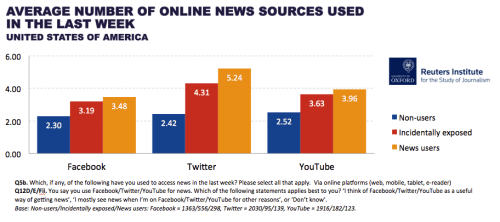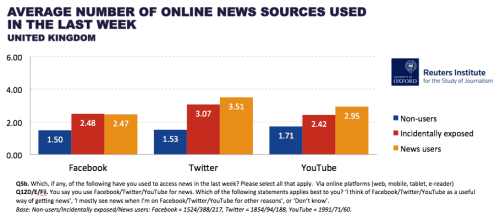By Richard Fletcher and Rasmus Kleis Nielsen
In the wake of the US election result in November and earlier in the year the outcome of the UK referendum on the European Union, some have argued that the rise of social media and its increasing role as a source of news have led to a world where people get less and less diverse information.
The terminology varies—echo chambers, filter bubbles, etc.—but the underlying concern is the same: that the rise of social media means that people get less diverse news from a narrower range of sources.
But is that actually the case? At the moment, we know surprisingly little about how people get news via social media, and how social media platforms might shape news consumption. Much of the current discussion is driven more by worry than by evidence.
Data from the 2015 Reuters Institute Digital News Report might shed some light on what is going on. It suggests that social media users in fact use significantly more different sources of news than non-users, thus challenging the filter bubble hypothesis.
While both social media use and social media functionality have evolved since the survey was in the field in 2015, it provides an important pointer as to the implications of social media use, because it helps us distinguish between the news diet of (1) people who intentionally use social media to get news (News users), (2) people who use social media for other purposes and come across news in the process (the Incidentally exposed), and (3) people who never see any news on social media, or do not use it at all (Non-users).
When we compare the number of online news sources (e.g. BBC News, the Mail Online, the New York Times app or website, etc.) each of these three groups said they had used in the last week, and compared them to those who do not use social media, we see that social media use is in fact associated with being exposed to significantly higher number of online news sources.
Importantly, both those social media users who use the platforms for news (News users) and those who use social media for other reasons and in the process come across news (the Incidentally exposed) get news from significantly more different online news sources than non-users.
The data presented in Figure 1 (for the UK) and Figure 2 (US) below clearly show how those who do not use social media (the blue bar of Non-users) on average come across news from significantly fewer different online sources than those who do use social media (the red bar of News users and the yellow bar of the Incidentally exposed). The figure for the incidentally exposed is particularly important because the data suggests that social media users typically receive a ‘boost’ in the number of news sources they use each week, even if they are not actually trying to consume more news.


Furthermore, Figures 1 and 2 also show that the difference between those who intentionally use social media for news and those who are incidentally exposed is quite small; usually smaller than the gap between non-users and the incidentally exposed. In the case of Facebook in the UK, the gap is almost zero.
Put differently, the effect of incidental exposure is in some cases powerful enough to close gaps in news consumption between those who are motivated or interested enough to actively seek it out using social media, and those who use it for other purposes.
The data presented above are raw figures, but the patterns identified remain consistent even when we use regression analysis to control for demographic differences such as age, gender, income and education, as well as people’s level of trust and interest in the news. Social media use is thus associated with more diverse news use.
Of course, in some cases, using more different sources of online news will not in itself guarantee a more diverse news diet. It is possible that all the sources used by some respondents reflect the same basic political or ideological stance. A few respondents may use a high number of different but very similar, very partisan sources of news and thus still live in a filter bubble or echo chamber of sorts. Our data only captures the number of sources respondents say they have used in the past week, not the content they have actually consumed.
Nonetheless, in most cases, using significantly more different sources of online news is likely to result in a more diverse news diet, and social media users—both those who intentionally use social media for news and those who use the platforms for other purposes but come across news while on them—use more different sources of online news than people who do not use social media.
